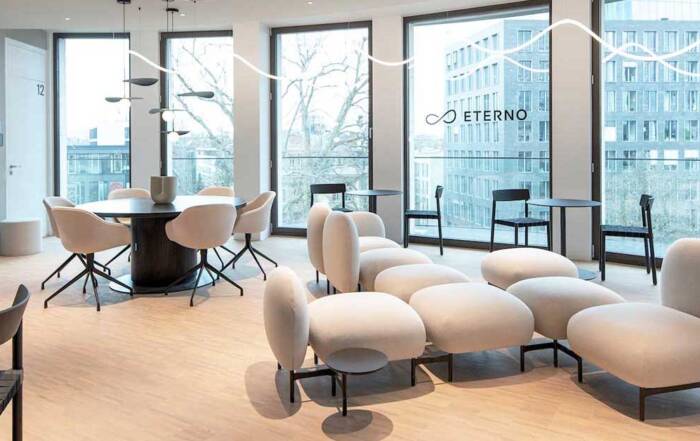Abdominal wall hernia surgery explained simply – what you need to know
An abdominal wall hernia often appears as a soft protrusion in the abdomen or groin (here a small umbilical hernia). An abdominal wall hernia occurs when a gap forms in the abdominal wall and internal organs (usually peritoneum or parts of the intestine) push outwards through this opening. A visible or palpable protrusion (hernia) can often be seen from the outside. The causes are usually weak points in the tissue in combination with increased pressure in the abdominal cavity - for example when lifting heavy loads or prolonged coughing.

Medically tested by:
Dr. Hamidreza Mahoozi, FEBTS, FCCP
First publication:
June 16, 2025
Updated:
August 25, 2025
An abdominal wall hernia does not heal on its own: in most cases, the gap remains permanently or even increases in size without treatment. The good news is that hernias can be treated very well today. Hernia operations are among the most common routine surgical procedures – in Germany alone, over 350,000 hernias are operated on every year. Patients can therefore be confident that a great deal of experience and modern technology are available for safe treatment.
Causes and risk factors of an abdominal wall hernia
An abdominal wall hernia can affect anyone, but occurs more frequently with certain risk factors. Typical causes and risk factors are
Weak connective tissue: Congenital or decreasing strength of the abdominal wall with age favors hernias. Some people are born with tissue weakness, while others lose stability over the years. Weak abdominal muscles can also contribute.
Increased internal abdominal pressure: Anything that greatly increases the pressure in the abdomen can trigger or enlarge a hernia. This includes heavy lifting and carrying, forceful pushing (e.g. in the case of chronic constipation) and persistent coughing. Pregnancy or severe obesity also increase the pressure in the abdomen and promote hernias.
Surgical scars: After previous abdominal surgery, an incisional hernia can develop at the scar. The tissue is weakened there and the scar can pull apart under stress. Wound healing disorders (for example due to infections, smoking or diabetes) further increase the risk of an incisional hernia.
Anatomical factors: Inguinal hernias (hernias in the groin area) occur more frequently in men, as their inguinal canal is naturally weak. Femoral hernias, on the other hand, mainly affect women. Umbilical hernias often occur in infants (they usually heal by themselves) and in overweight adults.
Why doesn’t a fracture heal by itself?
Once it has formed, the gap in the abdominal wall does not close by itself. The bulging peritoneum and tissue (hernia sac) may occasionally retract, but the hernial orifice – i.e. the opening in the abdominal wall – remains. During physical exertion, the bowel or peritoneum push outwards again and widen the opening further. Without treatment, a hernia can become larger over time and lead to more severe symptoms. There is also a risk of intestinal loops becoming trapped in the hernia sac (incarceration).
An incarcerated hernia is an emergency that must be operated on within hours, otherwise there is a risk of circulatory problems and inflammation. Conservative aids such as a hernia band (support belt) can temporarily hold back the hernia, but do not solve the problem – on the contrary: the permanent pressure can disrupt the blood flow to the skin and tend to weaken the abdominal wall muscles. Therefore, a hernia of the abdominal wall does not disappear spontaneously, and lasting healing is only possible through surgery.
Modern hernia treatment: how the operation works
Since a hernia does not grow back on its own, surgery is the only effective treatment. The procedure is usually minimally invasive (keyhole surgery) and is gentle. The prolapsed hernia sac is first pushed back into the abdominal cavity. The surgeon then closes the hernial orifice – often using sutures, supported by a fine plastic mesh to reinforce the abdominal wall.
With the minimally invasive method (laparoscopic surgery), a few small skin incisions are sufficient. A tiny camera (laparoscope) and instruments are inserted through these openings to repair the hernia from the inside.
This “keyhole” procedure has the advantage that it usually leads to less wound pain and faster recovery than a large abdominal incision. The surgical method chosen in each individual case (minimally invasive or conventional/open) depends on the type and size of the hernia and the patient’s state of health. At our hernia center, you will receive individual advice on which technique is best suited to you – with confidence and in line with the latest medical standards. (Find out more about the surgical method)
Hernia mesh – when is it used and how does it work?
A hernia mesh is a special plastic mesh (e.g. polypropylene) that is inserted into the abdominal wall during the operation. It serves as a permanent “plaster” to reinforce the abdominal wall. The mesh is positioned either in front of or behind the hernia gap and fixed in place with a few stitches or staples. When does a net make sense? In modern hernia surgery, a mesh is used for most hernias, especially if the hernial orifice is larger or the tissue is very weak. Studies show that this significantly reduces the risk of recurrence.
Smaller hernias (e.g. very small umbilical hernias) can in some cases be closed by suturing alone. Doctors often recommend inside, however, even for medium fractures, since Suturing procedures without mesh can lead to new fractures more frequently. The mesh material is flexible, fine-pored and well tolerated by the body. After the operation, it grows together with the surrounding tissue and forms a stable scar plate that supports the abdominal wall in the long term. You don’t have to imagine that you have a “foreign body” in your abdomen that is bothering you – patients normally feel it.inside the network at all.
Tolerance and prospects of success – what do the studies say?
Modern hernia meshes are considered safe and well tolerated. Serious rejection reactions are extremely rare. Of course, every implant is a foreign body that can cause complications in exceptional cases – for example infections, scarring or chronic pain. But these cases are the exception. Large registry studies and many years of experience show that most patients are very satisfied and become symptom-free after the operation.
According to experts, persistent, relevant pain only occurs in around 1 % of those operated on. The success rate is also high: only around 1-5 out of 100 patients suffer a recurrence of the fracture, and with mesh this rate is only around half as high as without mesh in the first few years. In other words: Around 95-99% of hernias can be permanently repaired. The operation usually leads to a significant improvement in quality of life, especially if there was previously pain or restrictions.
In order to further improve the quality of treatment, the results of hernia surgery in Germany are continuously evaluated. For example, the data of thousands of patients are voluntarily entered into a nationwide hernia register (Herniamed) register. In this way, long-term results can be monitored over many years and optimal therapy procedures can be developed. For you as a patient, this means that the methods are constantly being improved and you benefit from the latest findings.
Do you have any questions or would you like to have your abdominal wall hernia examined? Don’t hesitate to get in touch with us – we are here for you with experience and empathy. Get in touch with our team now for a personal consultation. Make an appointment now and act early for the sake of your gut feeling – we will help you competently and empathetically!


